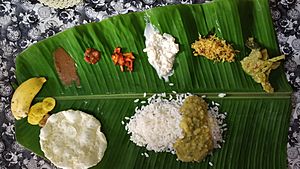Sadya facts for kids
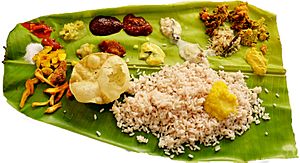 |
|
| Alternative names | സദ്യ |
|---|---|
| Place of origin | India |
| Region or state | Kerala |
Sadya (Malayalam: സദ്യ) is a special meal from Kerala, a state in India. It's a big, traditional vegetarian feast. People usually eat Sadya for lunch. It is served on a fresh banana leaf. The word "Sadya" means "banquet" in the Malayalam language. This meal is a very important part of festivals like Onam and Vishu in Kerala.
Contents
What is Sadya?
A typical Sadya can have about 24 to 28 different dishes. Sometimes, for very special events like the Aranmula Boatrace (Valla Sadya), there can be over 64 items! During a traditional Sadya, people sit on mats with their legs crossed. They eat the food with their right hand, without using forks or spoons. They cup their fingers to scoop up the food.
The main part of the meal is plain boiled rice. Many different curries and side dishes are served with it. These include curries like parippu, sambar, rasam, and others such as kaalan, avial, thoran, olan, pachadi, kichadi, koottukari, and erissery.
You'll also find mango pickle, injipuli, mezhukkupuratti, and naranga achaar (lime pickle). Crispy papadam, plantain chips, sharkara upperi, a banana, plain curd, and buttermilk are also served. The buttermilk is usually served at the end of the meal.
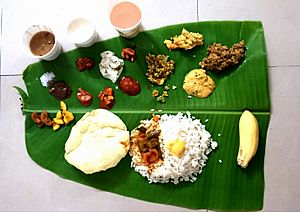
After the main dishes, a traditional dessert called payasam is served. There are many types of payasam, and often three or more kinds are offered. Some popular types are Paal Ada prathaman, Ada pradhaman, Parippu prathaman, and Chakkaprathaman. Each curry has a different vegetable and flavor. The many different dishes show how rich and healthy the meal is.
The dishes are placed in specific spots on the banana leaf. For example, pickles go on the top left, and the banana on the bottom left. This helps the people serving know where to put more food. Most Sadya dishes use vegetables, coconut, and coconut oil. This is because these ingredients are common in Kerala. Coconut milk is used in some dishes, and coconut oil is used for frying.
Sometimes, the Sadya menu can change based on the area or religion. Some groups in northern Kerala might even include meat dishes. While traditional Sadyas use local vegetables, it's now common to see carrots, pineapples, and beans. Usually, onions and garlic are not used in a Sadya. After the meal, people might chew vettila murukkaan, which is a betel leaf with lime and arecanut. This helps with digestion and cleans your mouth.
How Sadya is Prepared
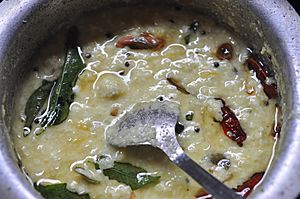
Sadya is usually a lunch meal, but a lighter version can be served for dinner. People start preparing the night before. All the dishes are ready by ten in the morning on the day of the celebration. Nowadays, Sadya is often served on tables, as it's not always easy for everyone to sit on the floor. Getting the right ingredients for Sadya is a careful process to make sure everything is good quality.
Before cooking, a prayer is offered to Agni (the god of fire). The very first serving of Sadya is placed on a banana leaf in front of a lit traditional lamp as an offering to God. In the past, neighbors would help the cooks all night. They would also help serve the food to the guests. This was a great way for people to connect and build friendships in the community.
Sadya is served in "pankthi" or "panthi," which means in lines or rounds. People sit in lines to eat. There can be many lines depending on how many guests there are. The hosts usually eat during the very last round. They walk around to greet guests and make sure everyone is enjoying the meal.
After finishing the meal, the banana leaf is folded and closed. If you fold the leaf towards you, it usually means you really enjoyed the meal. If you fold it away from you, it can mean the meal could be better. However, the meaning of folding the leaf can be different in various parts of India.
The Sadya from Central Travancore is known for being very traditional and organized. Dishes are served in a specific order, starting with chips and pickles. But in other parts of Kerala, there might be different ways of making and serving the dishes, based on local tastes.
Main Sadya Dishes
The Sadya includes many delicious items:
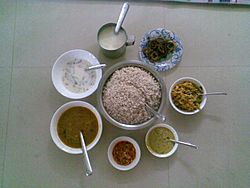
- Rice: This is the main part of the Sadya. It's usually Kerala red rice, which is a semi-polished brown rice.
- Parippu: A thick lentil curry eaten with rice, papadum, and ghee (clarified butter).
- Sambar: A thick gravy made from lentils, tamarind, and vegetables like drumsticks and tomato. It's flavored with asafoetida.
- Rasam: A watery dish made with tamarind, tomatoes, and spices like black pepper. It's spicy and helps with digestion.
- Avial: A mix of different vegetables and coconut, seasoned with curry leaves and coconut oil.
- Kaalan: Made with curd, coconut, and one vegetable like plantain or yam. It's thick and a bit sour.
- Olan: A light dish made from white gourd or black peas, coconut milk, and ginger.
- Koottukari: Vegetables like banana or yam cooked with chickpeas, coconut, and black pepper.
- Erissery: A thick curry made from pumpkin, black-eyed peas, and coconut.
- Pachadi: A sour curry made with curd and usually cucumber or ash gourd. It's cooked with coconut and mustard seeds.
- Sweet Pachadi: A sweet version of Pachadi, made with pineapple, pumpkin, or grapes in curd. It's also called Madhura (sweet) curry.
- Pulisseri: A sour, yellow curry made with slightly sour yogurt and cucumber. A sweet version, Mambazha Puliseri, uses ripe mangoes and jaggery.
- Injipuli: A sweet and sour pickle made of ginger, tamarind, green chilies, and jaggery.
- Thoran: A dish of sautéed vegetables like peas, green beans, or cabbage with grated coconut.
- Mezhukkupuratti: Vegetables stir-fried with spices. Sometimes chopped onions are added.
- Achaar: Spicy pickles made from raw mango (Mango pickle), lemon, or lime (Narangakari).
- Pappadam: Crispy and made from lentil flour. It's often eaten as a starter.
- Sharkara upperi: Banana chips coated with jaggery.
- Kaaya Varuthathu: Plain banana chips.
- Banana: A ripe banana is often served to eat with the dessert, Payasam.
- Sambharam: Also called moru, this is a drink made from salted buttermilk with green chili, ginger, and curry leaves. It helps with digestion and is usually served at the end.
These side dishes are followed by desserts like Prathaman and Payasams. There's a strict order for placing ingredients on the banana leaf. The Aranmula Valla Sadya is very famous, with over 64 items served in the traditional way.
Prathaman Desserts
Prathaman is a sweet, thick liquid dessert. It's similar to payasam but has more ingredients and is made in a more complex way. It's made with white sugar or jaggery and coconut milk. The main difference is that prathaman uses coconut milk, while many payasams use cow's milk.
- Palada prathaman is made from cooked rice flakes, milk, and sugar.
- Pazha prathaman is made from cooked plantain or banana with jaggery and coconut milk.
- Gothambu prathaman is made from broken wheat.
- Parippu prathaman is made from green gram.
- Chakka prathaman is made from jackfruit.
- Ada pradhaman is made from rice flakes.
- Kadala prathaman is made from black gram.
Glossary of Ingredients
- കായം - Asafoetida
- കുമ്പളങ്ങ - Ash gourd
- പഴം - Banana
- കടലക്ക - Bengal gram
- പാവക്കായ്/കൈപ്പകായ് - Bitter gourd
- ഉഴുന്ന് - Black gram
- കുരുമുളക് - Black pepper
- വെണ്ണ - Butter
- മുട്ടക്കൂസ് - Cabbage
- ഏലക്ക - Cardamom
- കശുവണ്ടി പരിപ്പ്/പറങ്കണ്ടി പരിപ്പ് - Cashew nut
- മുളകുപൊടി - Chili powder
- നാളികേരം/തേങ്ങാ - Coconut
- വെളിച്ചെണ്ണ - Coconut oil
- മല്ലി/കൊത്തുമല്ലി - Coriander
- വൻപയർ - Cowpea
- ജീരകം - Cumin
- ഈന്തപഴം/കാരക്ക - Dates
- മുരിങ്ങക്കായ് - Drumstick
- വഴുതനങ്ങ - Eggplant (Brinjal)
- പെരുംജീരകം - Fennel
- ഉലുവ - Fenugreek
- വെളുത്തുള്ള - Garlic
- നെയ്യ് - Ghee
- ഇഞ്ചി - Ginger
- പച്ചമുളക് - Green Chili
- കടലയെണ്ണ - Groundnut oil
- നെല്ലിക്കായ് - Indian gooseberry
- ചക്ക - Jackfruit
- ശർക്കര - Jaggery
- ചെറുനാരങ്ങാ - Lemon
- മാങ്ങാ - Mango
- പാൽ - Milk
- ചെറുപയർ - Mung bean
- എണ്ണ - Oil
- വെണ്ടക്കായ് - Okra
- സവാള - Onion
- മധുരനാരങ്ങ - Orange
- പാൽക്കട്ടി - Paneer
- പയർ - Pea
- കൈതച്ചക്ക - Pineapple
- ഏത്തക്കായ്/നേന്ത്രക്കായ് - Plantain
- ഉരുളക്കിഴങ്ങു - Potato
- മത്തങ്ങാ - Pumpkin
- ഉണക്കമുന്തിരി - Raisin
- ഉപ്പ് - Salt
- നല്ലെണ്ണ/എള്ളെണ്ണ - Sesame oil
- ചുവന്നുള്ളി - Shallot
- ചീര - Spinach
- പഞ്ചസാര - Sugar
- മഞ്ഞൾ - Turmeric
- മഞ്ഞപ്പൊടി - Turmeric powder
- വാളൻപുളി - Tamarind
- മരച്ചീനി/കപ്പ/കൊള്ളി - Tapioca
- ചേമ്പ് - Taro
- തക്കാളിക്ക - Tomato
- ചേന - Yam
See also
 In Spanish: Sadhya (comida) para niños
In Spanish: Sadhya (comida) para niños


